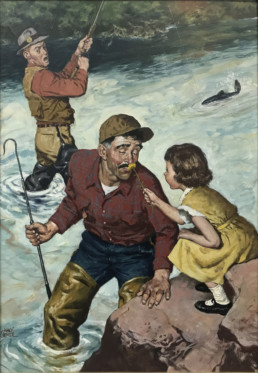Fly Fishing
Amos Sewell (American, 1901–1983)
Fly Fishing, ca. 1950
oil on panel
2019.051.131
Distracted by a young child’s offer to pause and smell a freshly picked flower, a guide leaves an angler’s side midstream. The guide is unaware that a fish has just grabbed hold of the angler’s fly and is missing the critical moment to snag the fish with his gaff before the line gives way in the thralls of the fight. Amos Sewell’s painting of the guide’s momentary forgetfulness, spurred by nature’s beauty, is a moving message for nonviolence amidst a time that violent imagery plagues the nation. The young girl’s innocence unlocks a wisdom that may have been lost by those viewing this illustration in the mid-twentieth century, reminding American audiences of the power of peace and the beauty that still exists in the surrounding world. Because gaffing results in severe injuries if not death, it is now illegal in North America to use this method to catch game fish.
The young girl in Fly Fishing is a romantic representation of childhood innocence typical of the works by Amos Sewell. Alongside Norman Rockwell, Sewell is recognized today as one of the best illustrators who worked for the Saturday Evening Post. Before picking up his paintbrush, Sewell always took the time to understand the mindset of his characters. Similar girls wearing bright yellow dresses, fresh white socks, and black-buckle shoes made appearances in his illustrations throughout the 1950s: catching the bus or, slightly older, attending a local dance. Sewell gives each character so much personality and spirit, one can’t help but to imagine that through these look-alikes, Sewell has created glimpses of the girl—emblematic of peace and beauty—living out her life within a narrative that crosses the boundaries from one canvas to the next.


